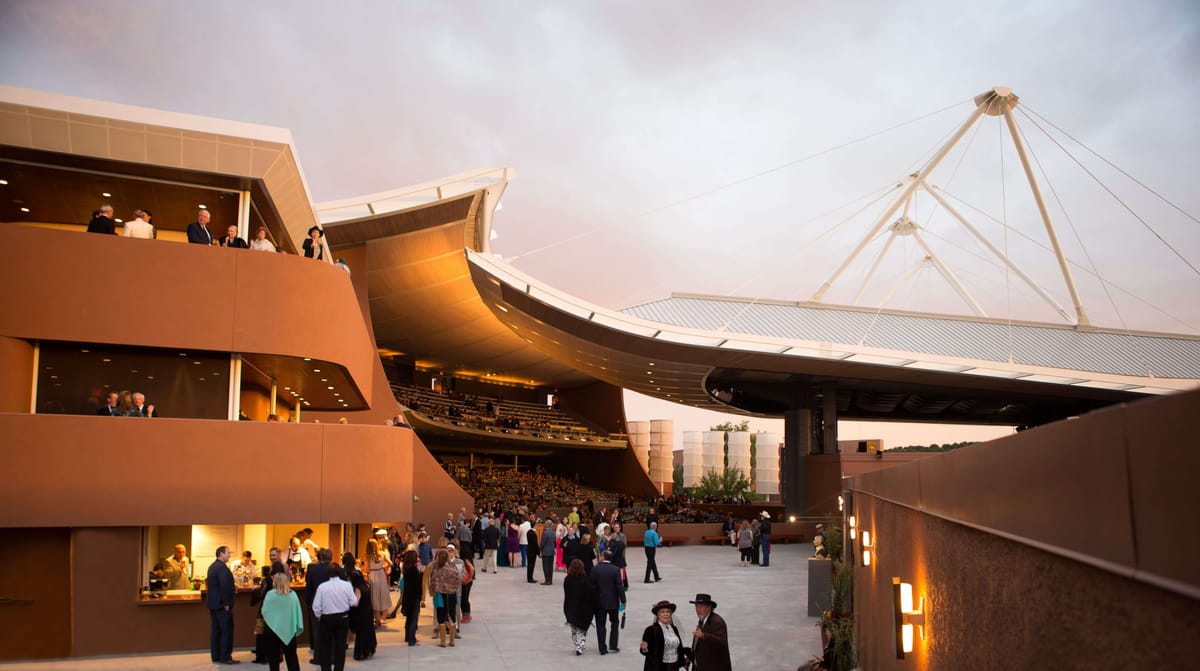
Oklahomans (including this writer) love zipping over to Santa Fe. Leave first thing in the morning and you’ll be at the Shed, margarita in hand, by happy hour. That’s reason enough. It’s quick—a handful of good podcasts and, bada bing, there you are. In summer months, when Oklahoma heat is doing its best to melt your entire house and set fire to your sanity, serene Santa Fe beckons with its low-key chic and groovy high-desert vibe. Meander the Plaza, head for the hills for a pretty hike and soak your cares away at Ten Thousand Waves. For those who love it, lovely, lyrical Santa Fe is nearly impossible to resist.
But there’s another siren song in Santa Fe you should know about: this one a silken aria gliding on a zephyr, emanating from Santa Fe Opera’s magnificent home set high on top of a mesa seven miles outside of town. To its west is a stunning view of the Jemez Mountains, to its east are the Sangre de Cristo Mountains. And there, perched between them, is the majestic 155-acre compound containing the theatre and “Opera Ranch” first imagined by founder John O. Crosby in the 1950s. Well before Crosby got hold of it, the land had been used as a pinto bean plantation, pig farm and mink farm. When he first laid eyes on it, it had become a guest ranch that was already hosting its share of musical types, including conductors Efrem Kurtz, Fritz Reiner, Joseph Rosenstock, Herbert von Karajan and others.
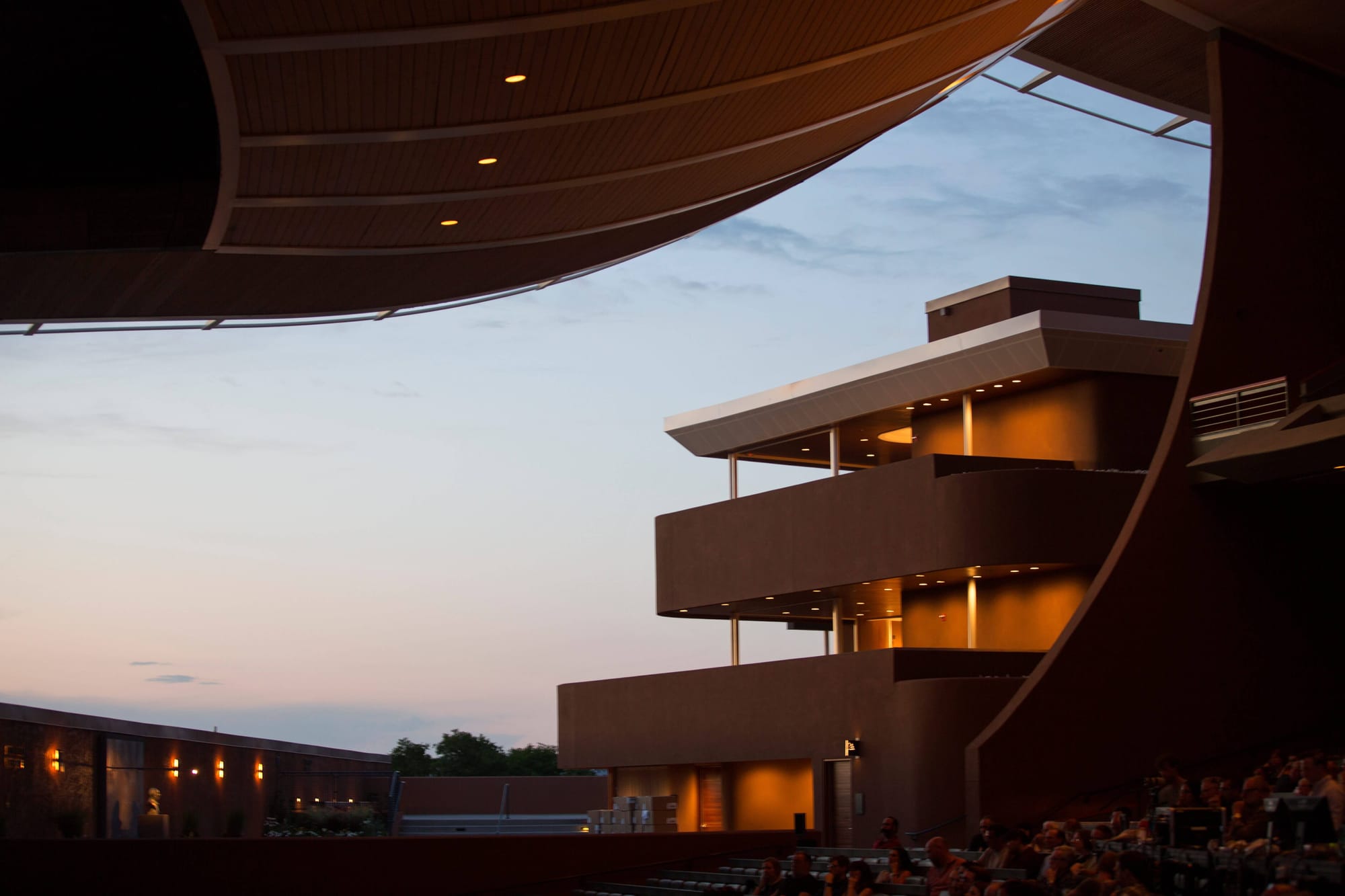
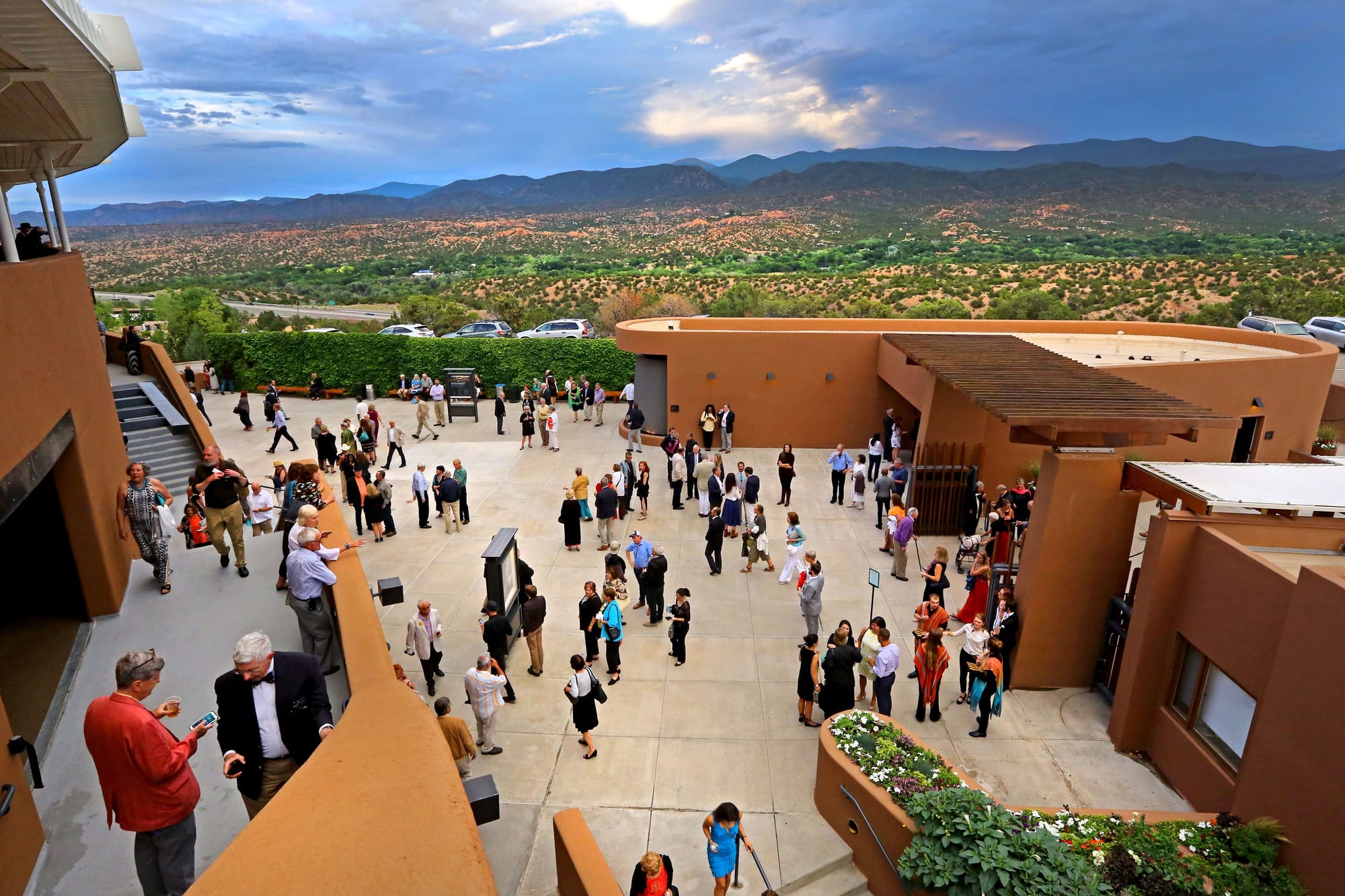
LEFT: Photo by Insight Foto / RIGHT: Photo by Kate Russell
The property is divided between the top of the mesa and the lower acreage called The Ranch. Up top, the striking, state-of-the-art, open-air, 2,126-seat Crosby Theatre is a living sculpture, with its two sweeping roofs joined by a clerestory; nearby Stieren Orchestra Hall is a three-story building used for rehearsals, costume storage, special events and pre-performance lectures. A 10-acre portion of The Ranch to the northeast houses offices, a swimming pool, a cantina and a spattering of rehearsal halls tucked into the craggy hillside.
TIME magazine called the complex “one of the handsomest operatic settings in the Western Hemisphere.” To The New Yorker, it is a “miracle in the desert.” More recently, The Washington Post dubbed it a “shining white cloud in the red hills.” And the Philadelphia Inquirer has lauded it as “one of the most beloved venues in the country.”
Crosby, a conductor from Bronxville, New York, attended New Mexico’s Los Alamos Boys School as a young teen due to his asthma and later studied at Yale and Columbia, where his love of opera took flight. When he retired in 2000, he talked with The New York Times about his clear, early vision for Santa Fe Opera:

“I was a youngster in New York,” he said, “one of this pool, if you will, of youngsters interested in music who did things like opera workshops. I played the violin in orchestras, I got to know singers and I knew instrumentalists. And we were talking about finding something to do in the summer in a nice place.”
Santa Fe occurred to him as a possibility, he said, because the city was known for being hospitable to the arts—particularly sculptors, authors and painters—yet it had virtually no musical life. With $200,000, provided by his father, he bought a ranch, seven miles north of Santa Fe in the Sangre de Cristo mountains. He built a 480-seat wooden theater on the grounds, hired a company of about 65, including singers, orchestra players and crew, and opened the company’s first season with a performance of Puccini’s Madama Butterfly on July 3, 1957, a few days short of his 31st birthday.
The man is often described as soft-spoken, but his sense of drama was outsized. Take this fearless move, for example: In his first season, Crosby invited Igor Stravinsky to Santa Fe to lead the production of The Rake’s Progress, instantly creating a sensation and putting Santa Fe Opera on the map. During his tenure, he also embraced new and rarely performed works, presenting the American—or world—premieres of nearly 50 of them.
Crosby also understood that he had to embrace the uniqueness of his location. Another excerpt from the The New York Times: “I felt that it would not make sense to try to run a museum of opera in a small mountain town like Santa Fe. You can have all the Bohèmes and Carmens you want in New York, all winter, with brilliant international casts, and you don’t have to come here to see them. But if you have an interest in some unusual things then you will come along.” Of course, crowd-pleasing classics like La Traviata are also regular parts of the season but, even today, so are new works.
The 2024 season saw the world premiere of The Righteous, set in the 1980s American Southwest. Written by composer Gregory Spears and former U.S. Poet Laureate and Pulitzer Prize winning librettist (opera lyricist) Tracy K. Smith, The Righteous is a timely exploration of the intersection between political power and genuine faith. Says Spears: “The opera tells the story of David, a preacher and leader of a growing church who finds himself caught up in the confluence of religion and politics in the 1980s, alongside contemporary events including the rise of feminism, the war on drugs, conflict in the Middle East and the AIDS epidemic. Throughout the narrative, we see how the feeling of being called to serve God can be so easily influenced by human frailty and desire.”
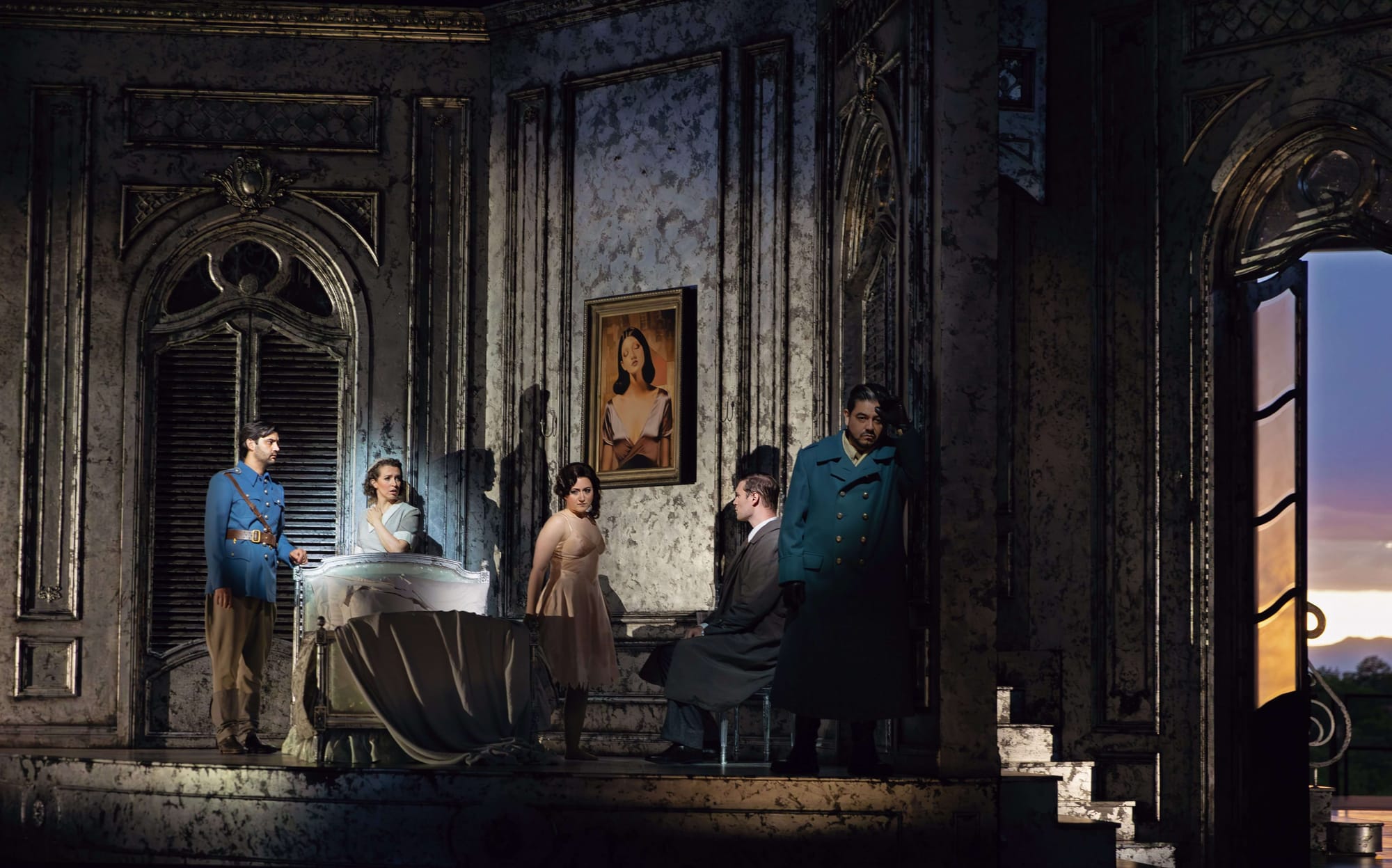
For the Rev. Susan Esco Chandler, Santa Fe Opera trustee and arguably one of its biggest fans, her love of the art form began in an unlikely place: Oklahoma City, her hometown. “The Texaco company sponsored the Metropolitan Opera broadcast that used to be on Sunday afternoons for years,” she says, “and in Oklahoma, that was about the only way you could participate in opera—other than when I was a young girl, a traveling troupe actually came through Oklahoma City and performed La Boheme down at the old Municipal Auditorium. And I was fascinated. Here was a woman singing in bed and dying. I thought, ‘What? What is this story?’”
She realized that her fledgling love of opera could actually take wing without flying all the way to New York City. “I was able to get back into true opera because you could drive from Oklahoma City to Santa Fe, so some friends and I made the drive and went out. This was when the opera still didn’t have a roof on it. You sat on benches in the open, and you had your seat assigned, but you found it on a bench. If it rained, you had big plastic trash bags. You’d pull one up, then you’d pull one over, so you could sit there in the rain and watch the opera. It was quite an adventure back in those days,” Chandler says.
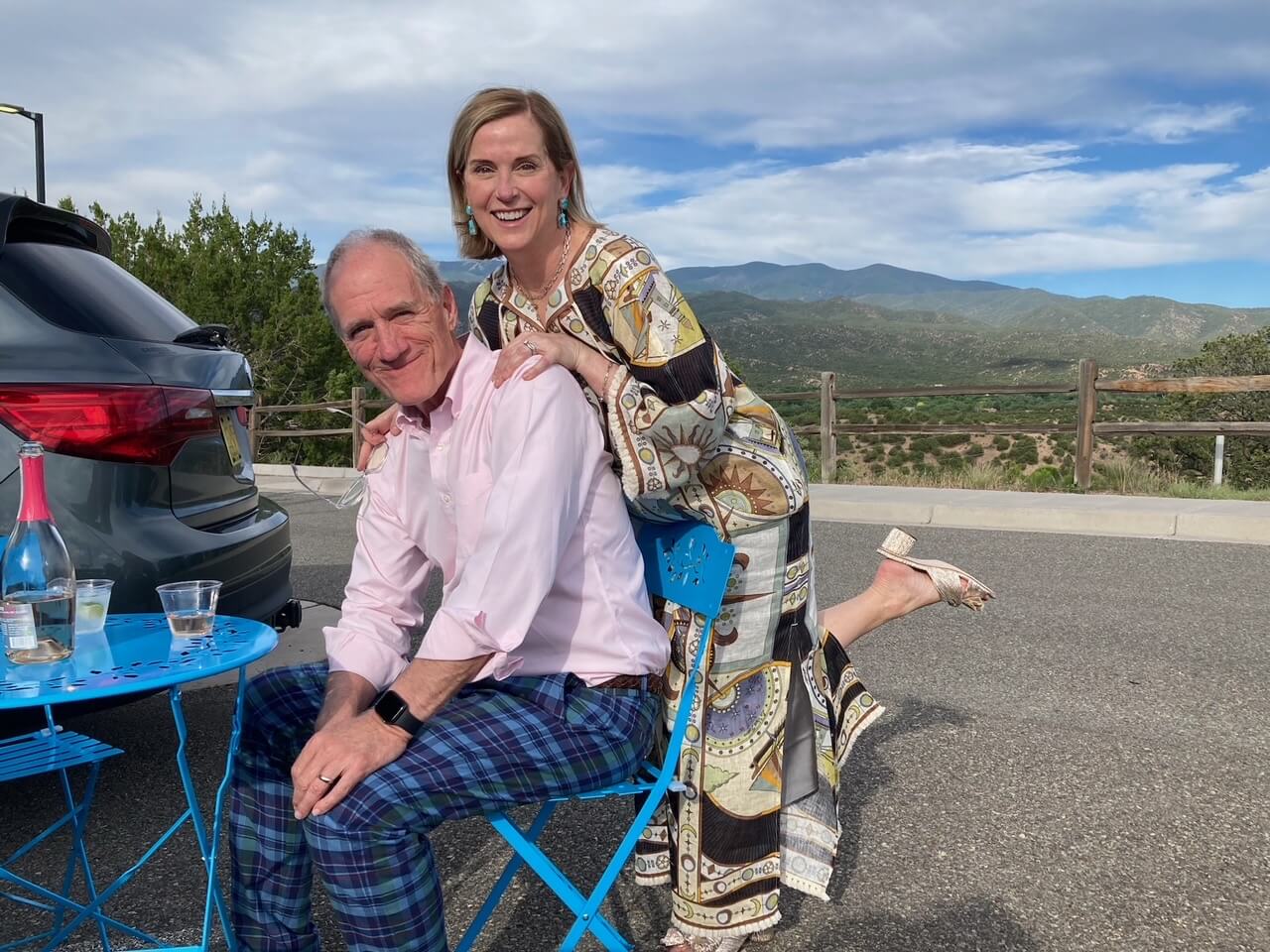
She’s been on the board for a decade; she’s also on the board of the Arizona Opera, and she and her husband are supporters of New York’s Metropolitan Opera. The pair met and married 23 years ago when she was living in New York City and he was in Boston. “For one of our first dates, I said, ‘Oh, they’re doing Don Giovanni, why don’t you come and be my guest?’” And he did. “Then, about six months later, he said, ‘Guess what? The Boston Lyric Opera is doing Don Giovanni. We’ve got to see it again.’ And we decided, after you’ve seen Don Giovanni twice in one year, you should get married. That’s all there is to it.”
Chandler estimates that she sees 20 or more opera performances a year. The performances themselves are only part of the draw. “There’s no wrong reason to come to the theater to see a live production and hear the voices singing right there in front of you with the orchestra and all of this … community. And you feel the energy of other people who are experiencing the same thing you are, yet everybody is hearing it a little differently, or in their heart, they’re feeling it a little differently,” Chandler says.
And she fervently hopes that if you have never seen an opera, that you’ll give it a go. Why? “I think there’s no more beautiful instrument than the human voice.” •
The Luxiere List: Tailgating Like a Maestro
Consider hiring transportation.
Chandler recommends this for first-timers. Services like New
Mexico Black Car Limousine and Taxi Service are a great option. They’ll drop you at one of the many picnic tables if you’ve brought supper; many services also offer tailgate menus and will do all the work for you. They’ll also get you back to town after the performance. While leaving the venue isn’t exactly difficult, it can certainly be a little chaotic and slow-moving.
Watch the weather
Oklahomans know to be weather aware, and it’s just as important on opera night. “You get your weather app, get it up, set up for Santa Fe and just follow it like a Bible,” Chandler says. Be sure to bring along an extra layer, a fleece or a wrap, because the high desert cools down fast in the evening.
Go early
Leisurely should be the aspirational pace of the meal. If you’ve driven yourself, you’ll marvel at how well-directed the traffic is. Once ensconced between your white lines, set up your seating and start with drinks and apps. Meander through your main, and saunter through dessert.
Box it
Tailgating at the opera is a BIG deal in Santa Fe, and plenty of places offer terrific boxed meals. Kaune’s Neighborhood Market (kaunes.com, pronounced “Connie’s”) is a gourmet grocer and café with a really lovely to-go boxed meal menu, filled with easy-to-eat treats like dolmas, custom chopped salads, legendary egg salad and an excellent wine selection to peruse when you pick up. Santa Fe Opera also offers boxed charcuterie, samplers and dinners—but you’ve got to order them two days ahead.
Anything goes
Wander through the parking lot and you’ll see tuxes, white
tablecloths, crystal flutes and freshly-polished silver candelabra. We’ve even spotted a group with hired service staff! You’ll also see folks with card tables and camping chairs in pickup truck beds, dining on pizza and brews. It’s literally all good.
But a theme is great, too
Our recent theme: “Cold Champagne supper.” We realized it with a super-decadent cheese board, chilled roasted salmon, gazpacho, salads, quiche and roasted asparagus. Dessert was
easy—macrons! Themes based on the performances are another great idea.
Anything goes, clothing edition
There is no dress code, and that’s part of the joy. You’ll see folks in formalwear, definitely, alongside people in jeans, casual dresses and Tevas. You’ll also see sartorial Santa Fe at its finest, that offhand blend of sun-faded natural fiber dresses and tunics, bold jewelry and luxe hippie footwear. It’s a wonderful mishmash.

